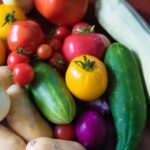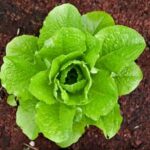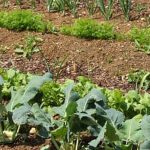Colorado Mountain Vegetable Gardening presents a unique set of challenges and opportunities for gardeners in the high-altitude regions of Colorado. The state’s diverse climate, rocky terrain, and extreme weather conditions require careful planning and specialized techniques for successful cultivation.
In this article, we will explore the essentials of Colorado mountain vegetable gardening, focusing on understanding the climate and soil conditions, selecting the best vegetables to grow, tips for success at high altitudes, choosing the right location, recommended tools and equipment, pest management strategies, harvesting and preservation methods, as well as community resources and events for fellow mountain gardeners.
Colorado’s mountain regions offer a picturesque backdrop for vegetable gardening enthusiasts to unleash their green thumbs. However, before diving into planting seeds in this challenging environment, it is crucial to understand the unique climate and soil conditions that characterize these elevated landscapes.
From frost-prone nights to short growing seasons and nutrient-depleted soils, Colorado mountain gardeners must adapt their practices to ensure healthy crops each season. By leveraging knowledge about the local environment, gardeners can overcome these obstacles with smart planning and diligent care.
When it comes to selecting which vegetables thrive in Colorado’s mountain climate, a strategic approach is key. Certain crops like hearty root vegetables and leafy greens tend to fare well in cooler temperatures and shorter growing seasons typically experienced at higher elevations.
By choosing varieties that are better suited to withstand harsh conditions while maximizing available sunlight and water resources, gardeners can increase their chances of a bountiful harvest. Stay tuned as we delve deeper into specific recommendations on the best vegetables to grow in Colorado’s mountain regions later in this guide.
Understanding the Climate and Soil Conditions in Colorado’s Mountain Regions
Nestled in the beautiful, rugged landscapes of Colorado’s mountain regions, vegetable gardening presents a unique set of challenges and opportunities. Understanding the specific climate and soil conditions of these high altitude areas is crucial for successful cultivation.
The climate in Colorado’s mountain regions can vary significantly from the lower elevations, with shorter growing seasons, cooler temperatures, and greater temperature fluctuations. The USDA hardiness zone for these areas typically ranges from 3 to 5, meaning gardeners must be mindful of frost dates and select vegetables that can thrive in such conditions.
When it comes to soil conditions, Colorado mountain vegetable gardening enthusiasts may encounter rocky, well-drained soils that are low in organic matter. To improve soil quality and fertility, consider amending the soil with organic matter such as compost or aged manure. Additionally, performing a soil test can provide valuable information on nutrient levels and pH balance, allowing you to make informed decisions on fertilization and soil amendments.
To navigate the unique challenges posed by Colorado’s mountain climate and soil conditions, here are some key considerations:
- Select cold-hardy vegetables that can withstand sudden temperature drops
- Extend your growing season by utilizing season extenders like row covers or hoop houses
- Use raised beds to improve drainage and increase soil temperatures
- Monitor weather patterns closely to protect your plants from late spring frost or early fall frosts
By understanding and adapting to the specific climate and soil conditions of Colorado’s mountain regions, vegetable gardeners can cultivate a bountiful harvest despite the challenges presented by high altitudes.
Best Vegetables to Grow in Colorado’s Mountain Climate
When it comes to Colorado mountain vegetable gardening, choosing the right vegetables to grow can make a significant difference in the success of your garden. Due to the unique climate and soil conditions found in Colorado’s mountain regions, certain vegetables thrive better than others. One of the key considerations when selecting vegetables for your mountain garden is to opt for cold-hardy varieties that can withstand the cooler temperatures and unpredictable weather common at higher altitudes.
Some of the best vegetables to grow in Colorado’s mountain climate include root vegetables like carrots, beets, and radishes. These hardy crops can tolerate the colder temperatures and shorter growing seasons typically experienced in mountain regions.
Leafy greens such as lettuce, kale, and spinach also do well in Colorado’s mountains, providing fresh salads throughout the growing season. Additionally, cruciferous vegetables like broccoli, cauliflower, and Brussels sprouts are excellent choices for mountain gardens due to their ability to thrive in cooler temperatures.
Another great option for Colorado mountain vegetable gardening is herbs such as thyme, oregano, and chives. These aromatic plants not only add flavor to your dishes but also attract beneficial insects to your garden.
Furthermore, legumes like peas and beans are well-suited for mountain gardens as they fix nitrogen into the soil, enriching it naturally. By choosing a variety of these resilient vegetables and herbs, you can create a bountiful harvest in your Colorado mountain garden while enjoying fresh produce throughout the growing season.
Tips for Successful Vegetable Gardening at High Altitudes
When it comes to successful vegetable gardening at high altitudes in Colorado’s mountain regions, there are several important factors to consider. The unique climate and soil conditions can present challenges for gardeners, but with the right knowledge and techniques, anyone can have a thriving mountain vegetable garden.
Understanding Altitude Challenges
At higher altitudes, gardeners may face colder temperatures, stronger UV radiation, and shorter growing seasons. These factors can impact the types of vegetables that can be grown successfully. It is important to choose cold-hardy varieties and pay attention to planting dates in order to maximize your harvest.
Utilizing Season Extension Techniques
To overcome the challenges of a shorter growing season in Colorado’s mountain regions, consider utilizing season extension techniques such as hoop houses, row covers, or cold frames. These tools can help protect your plants from frost and allow you to extend your growing season well into the fall.
Proper Watering and Mulching
In the dry climate of Colorado’s mountains, proper watering is essential for a successful vegetable garden. Be sure to water deeply but infrequently to encourage deep root growth. Additionally, mulching around your plants can help retain moisture in the soil and reduce evaporation. Consider using organic mulches like straw or wood chips for best results. By implementing these tips and techniques, you can enjoy a bountiful harvest of fresh vegetables from your Colorado mountain garden.
Choosing the Right Location for Your Mountain Vegetable Garden
Choosing the right location for your Colorado mountain vegetable garden is crucial to ensure a successful harvest. Here are some tips to help you make the best decisions for your garden:
1. Sunlight: Select a spot that receives at least 6-8 hours of sunlight per day, as this is essential for the growth and development of most vegetables. In the mountainous regions of Colorado, this can be challenging due to the presence of tall trees or buildings that may block the sunlight. Consider trimming trees or choosing raised beds to maximize sunlight exposure.
2. Wind Protection: Colorado’s mountain regions can experience strong winds, which can damage delicate vegetable plants. To protect your garden, choose a location that is sheltered from strong winds, such as near a fence or natural windbreak like shrubs or trees.
3. Water Accessibility: Ensure that your chosen location has easy access to water for irrigation purposes. Consider placing your garden near a water source such as a hose connection or installing a rainwater harvesting system to collect water for your vegetable garden.
By carefully considering these factors when choosing the location for your Colorado mountain vegetable garden, you can create an optimal environment for your plants to thrive despite the unique challenges of gardening in high altitudes. With proper planning and preparation, you can enjoy a bountiful harvest of fresh and delicious vegetables from your own backyard.
Recommended Tools and Equipment for Mountain Vegetable Gardening
Colorado mountain vegetable gardening can be a rewarding experience, but it does require some specific tools and equipment to ensure success. In the high-altitude environment of Colorado’s mountain regions, having the right gear can make all the difference in maintaining a healthy and thriving garden.
One essential tool for mountain vegetable gardening is a soil thermometer. Since the temperature in these regions can vary greatly, a soil thermometer will help you determine the best times for planting specific vegetables. Additionally, raised garden beds are highly recommended for mountain gardening as they help with drainage and warming up the soil faster in the spring.
Investing in quality watering equipment is also crucial for Colorado mountain vegetable gardening. Drip irrigation systems or soaker hoses work well to deliver water slowly and directly to the roots of your plants, minimizing evaporation at high altitudes where sun exposure and dry air can quickly dry out the soil. Additionally, a sturdy shovel, hand trowel, and hoe are necessary tools for planting, weeding, and maintaining your garden throughout the season.
| Recommended Tool/Equipment | Description |
|---|---|
| Soil Thermometer | Helps determine best planting times based on temperature variations |
| Raised Garden Beds | Aids in drainage and warms up soil faster during colder seasons |
| Drip Irrigation System/Soaker Hoses | Delivers water directly to plant roots to prevent evaporation |
Overall, having the right tools and equipment specifically tailored to Colorado mountain vegetable gardening can significantly increase your chances of a successful harvest. By equipping yourself with these essential items, you’ll be better prepared to deal with the unique challenges that come with high-altitude gardening in Colorado’s stunning mountain landscapes.
Dealing With Pests and Wildlife in Colorado’s Mountain Gardens
Colorado mountain vegetable gardening comes with its own set of challenges, one of the most common being pests and wildlife that can wreak havoc on your carefully tended plants. In this region, gardeners may encounter pests such as aphids, cutworms, deer, rabbits, and even bears. Learning how to deal with these potential threats is essential for a successful harvest.
To protect your mountain garden from pests like aphids and cutworms, consider using natural remedies such as neem oil or insecticidal soap. These solutions are effective at controlling common garden insects without harming beneficial pollinators. For larger pests like deer and rabbits, installing fencing around your garden plot is often necessary. Make sure the fence is tall enough to deter these animals from jumping over.
In Colorado’s mountain regions, encounters with wildlife like bears can also be a concern for vegetable gardeners. To minimize the risk of attracting bears to your garden, avoid planting highly aromatic crops like melons or apples near wooded areas where bears may dwell.
Additionally, secure compost bins and garbage cans to prevent these curious animals from scavenging for food near your garden. By taking proactive measures to deter pests and wildlife, you can enjoy a bountiful harvest of fresh vegetables in your Colorado mountain garden.
| Pest/Wildlife | Control Measures |
|---|---|
| Aphids | Use neem oil or insecticidal soap |
| Deer/Rabbits | Install fencing around the garden area |
| Bears | Avoid planting aromatic crops near wooded areas; Secure compost bins and garbage cans |
Harvesting and Preserving Your Mountain Vegetables
After putting in the hard work of planting and caring for your vegetable garden in Colorado’s mountain regions, it’s time to reap the rewards by harvesting your produce. It is essential to understand the optimal time for harvesting each type of vegetable to ensure they are at their peak flavor and nutritional value.
Harvesting Tips
One key tip for harvesting vegetables in Colorado’s mountain climate is to pay close attention to the growing season. Due to the shorter growing season at higher altitudes, it is important to harvest vegetables promptly when they are ready. This not only ensures the best taste but also encourages continuous growth throughout the season.
Preservation Methods
Once you have harvested your mountain vegetables, it’s essential to properly preserve them to enjoy your home-grown produce all year round. Common methods of preserving vegetables include canning, freezing, pickling, and dehydrating. Each method has its advantages depending on the type of vegetable and personal preference.
Canning is a popular preservation method that involves sealing vegetables in jars with special lids after heating them at high temperatures. Freezing is another convenient way to preserve vegetables by blanching them before freezing in airtight containers or bags. Pickling adds flavor and extends the shelf life of vegetables by soaking them in a vinegar solution with spices and herbs. Dehydrating removes moisture from vegetables using low heat, making them shelf-stable for long periods.
Community Resources and Events for Colorado Mountain Vegetable Gardeners
In conclusion, Colorado mountain vegetable gardening offers a unique and rewarding experience for gardeners willing to navigate the challenges of high altitudes and unpredictable weather conditions. By understanding the specific climate and soil conditions of Colorado’s mountain regions, gardeners can choose the best vegetables to grow and implement tips for success in their gardens.
When it comes to community resources and events for Colorado mountain vegetable gardening enthusiasts, there are plenty of opportunities to connect with like-minded individuals and experts in the field. Local gardening clubs, workshops, and farmers markets provide valuable information and networking opportunities for those looking to enhance their gardening skills and knowledge. Additionally, online forums and social media groups offer a platform for sharing experiences, asking questions, and staying connected with the larger community of Colorado mountain vegetable gardeners.
As you embark on your own Colorado mountain vegetable gardening journey, remember to take advantage of the recommended tools and equipment suited for high-altitude gardening. From frost protection devices to specialized soil amendments, having the right supplies can make a significant difference in your garden’s success.
By persevering through challenges such as pests and wildlife encounters, harvesting your own fresh produce, and participating in community events, you can cultivate a thriving mountain vegetable garden that reflects the beauty and resilience of Colorado’s natural landscape.
Frequently Asked Questions
What Vegetables Can You Grow in High Altitude?
When it comes to growing vegetables in high altitudes, some of the most suitable options include radishes, carrots, lettuce, kale, spinach, peas, beets, and Swiss chard. These vegetables are known to thrive in cooler temperatures and shorter growing seasons typically found at high altitudes.
What Vegetables Do Well in Colorado?
In Colorado’s climate and soil conditions, certain vegetables tend to perform exceptionally well. Popular choices for vegetable cultivation in Colorado include tomatoes, peppers, cucumbers, zucchini, squash, onions, garlic, and various herbs like basil and oregano. These vegetables adapt well to the state’s varying weather patterns.
When Should I Start a Vegetable Garden in Colorado?
In Colorado, the ideal time to start a vegetable garden largely depends on the specific region within the state due to varying microclimates. However, as a general guideline for most areas in Colorado with cold winters, it is recommended to start planting cool-season crops like lettuce and peas in early spring (late March or April) and warm-season crops like tomatoes and peppers after the last frost date (typically around mid-May).
Planning ahead based on your specific location’s frost dates is crucial for a successful vegetable garden in Colorado.

If you’re looking to get into vegetable gardening, or are just looking for some tips on how to make your current garden better, then you’ve come to the right place! My name is Ethel and I have been gardening for years. In this blog, I’m going to share with you some of my best tips on how to create a successful vegetable garden.





